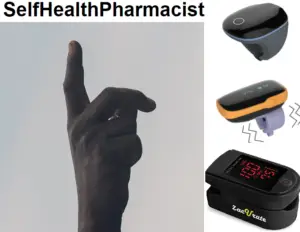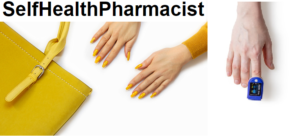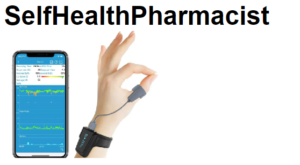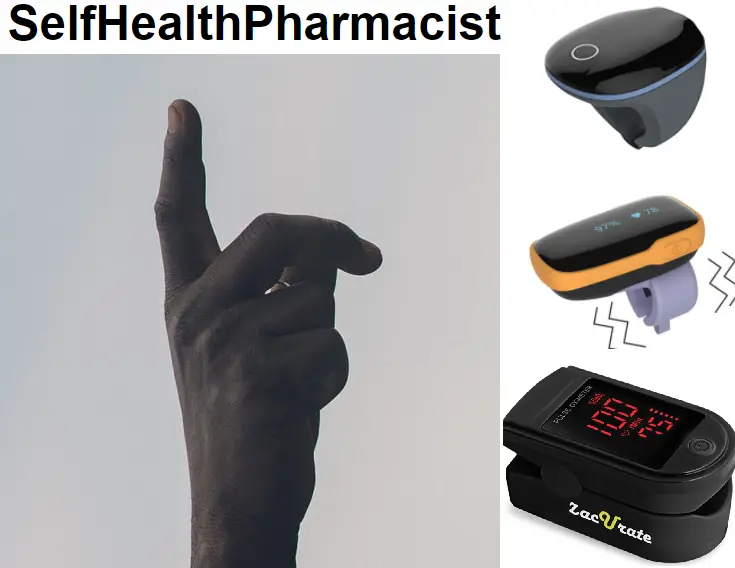Saturation can indirectly tell how well the lungs are working.
The Medical Pulse Oximeter will not explain what the problem is, but will help to alert it in time.
But of course there are some factors that influence saturation measurements. Let’s figure out this today together.
Device manufacturers may need to refine devices so that they give correct readings for all patients. Today, in the context of the COVID-19 pandemic, pulse oximeters are common not only among doctors, but also among ordinary people, and if the hospital has the ability to measure oxygenation in other ways, then at home, incorrect readings of the device can lead to the death of the patient.
Table of Contents
The Work Principle of the Pulse Oximeter
A pulse oximeter measures how bright our blood is.
The brighter, the more oxygen. Arterial blood is brighter because it has more oxygen. In venous blood – less – and it is darker. This feature underlies the operation of the pulse oximeter.

On one side of the device is the light source, and on the other side is the receiving sensor.
When you put your finger into a pulse oximeter, it sends different wavelengths of light through the pulsating blood. These rays shine through hemoglobin, a protein in red blood cells that carries oxygen. Not all hemoglobin attaches oxygen, but there is normally less “empty” protein.
Oxyhemoglobin and hemoglobin without oxygen absorb light waves of different wavelengths. The pulse oximeter analyzes the amount of transmitted light and translates the information into numbers. So we find out how many percent of our hemoglobin is saturated with oxygen.
Best pulse oximeter for Dark Skin
As I mentioned before, a pulse oximeter measures blood oxygen saturation by passing a beam of light through the finger on which the device is worn.
But in people with dark skin, the light through the finger may be worse – as a result, the pulse oximeter gives a higher saturation indicator than it actually is.
Even if the pulse oximeter is not accurate enough, the dynamics of saturation can indicate potential health problems in a person. The level of oxygen in the blood of a healthy person should be 95-99%, but in the case of chronic diseases of the respiratory or cardiovascular system, the figure can drop to 92-94%.
A drop in saturation is considered one of the manifestations of coronavirus disease – but it can also indicate respiratory failure of a different kind. In some cases, saturation can imperceptibly reach a critically low 50-70% – this condition is called “silent hypoxia”.
When choosing such a pulse oximeter for dark skin, it is better to give preference to more recent models that have the ability to detect movement and mark it with an artifact, or be resistant to movement through fast execution of calculations. It is worth knowing that even a non-professional pulse oximeter is characterized by an error in measurement of no more than 2-3%.
Pay attention to the modest pulse oximeter Wellue O2 Ring. This pulse oximeter works well with dark skin and gives accurate measurements.
The tracker ring is a device that monitors the health of people with dark skin with heart and lung diseases, sleep apnea attacks.
It is a very interesting device, useful for domestic use. Especially for quick real-time heart rate measurement. As for the parameters of saturation, for a healthy person it is not at all necessary to measure them constantly. As our experiments have shown, if you are healthy, then your saturation will always be normal. I hope you will never need to measure saturation in lung disease mode.
Statistics of Best Pulse Oximeter for Black skin
Pulse oximeters are four times more likely to be wrong when measuring the level of oxygen in the body of people with dark skin, US doctors found. Apparently, the work of the device is hindered by an excess of pigment.
According to statistics, people with dark skin and ethnic minorities are more likely to get severely ill with COVID-19 or die from it.
It is likely that the inaccuracy of pulse oximeter data may be the explanation for this.
According to some scientists, more than 300,000 pulse oximeters have been distributed in the UK to people with COVID-19 so that if the rate drops to 92% or lower, they can contact hospitals in advance.
Doctors recommend using other methods of oxygen control in hospitals.
The results suggest that doctors may need to use other tests to make sure that oxygen levels in black patients are normal.
Recommendations of Using Pulse Oximeter for people with dark skin
To determine the degree of saturation in the blood, it is important to take into account many factors.
Pulse oximeters are quite complex and capricious devices, so many inexpensive devices do not pass the tests that would be the basis for using devices in medical institutions.
For example, devices designed to screen for coronary artery disease should provide movement tolerance validated for low perfusion conditions.
Patients who are monitoring their condition at home are advised to pay attention to other signs and symptoms of low blood oxygen levels.
These may include discoloration of the skin, breathing problems and worsening cough, agitation, chest pain or tightness, and rapid heart rate.

Best Pulse Oximeter for Long Nails and Painted Nails
In social networks and on forums on the Internet, there are some warnings:
“Before measuring saturation, be sure to remove nail polish from your nails”. Why?
The absorption spectrum of nail polish is quite serious. And, including, it is in the infrared ranges that oxyhemoglobin “catches”. Based on this, I can conclude: a pulse oximeter on a finger with a painted nail will give distorted readings.
In fact, the varnish, due to the absorption of light waves, gives “noises” and interferes with normal measurements. And this can result in a distortion of the testimony in any direction.
The authors of the scientific work from Ankara (Gulhane Military Medical Academy, School of Nursing) measured saturation on fingers with varnished nails of different colors with three different pulse oximeter devices.
And also – for control – on hands without color manicure. As it turned out, the four colors of varnish most distorted the readings of the device: purple, beige, white and blue.
In fact, any color of varnish can give certain distortions, because one way or another, the coating on the nails will partially absorb light waves.
In general, the deviation of pulse oximeter readings due to nail polish can be up to 2%. This is very serious – given the fact that at saturation, 93% of the patients must be hospitalized.
Here is a list of “deceptive” factors given by the authors of a scientific paper in the journal of the American Association of Nurse Practitioners (The Journal for Nurse Practitioners).
– Bright light or sunlight: False signal boost (exaggerated saturation).
– Cold room: Bad signal
– Trembling, chills, movement during measurements: Bad signal
– Sensor height above heart level (e.g. raised arm overhang): Bad signals
– Dirty sensor: Bad signal
Pay attention to the modest pulse oximeter that does not work with nail measures at all :Wellue SleepU

The pulse oximeter continuously can measure your blood oxygen saturation, heart rate and frequent body movements at night by not touching painted long nails.
It measures just blood oxygen, pulse rate, and motion. It has a silent vibration instead of annoying audible beeping. It has Vibration For Low Oxygen Levels.
Has 3 warning system
It is rechargeable. The pulse oximeter has a built-in lithium polymer rechargeable battery.
How to Avoid Errors in Fingertip Pulse Oximeters?
- Take measurements in a calm state and sitting.
- Select a finger on the dominant hand without varnish and without bruising.
- Place your finger securely between the clamps on the pulse oximeter with your fingernail facing up.
- Place your hand on a flat surface. Make sure that it is not raised: the blood should not flow from the tip of the finger.
- The pulse oximeter will show the percentage of blood oxygen saturation in 10-20 seconds. For reliability, you can continue the measurement for several minutes. So the device will be able to analyze the data longer and give a more accurate average value.
- If you think the pulse oximeter is wrong, test it on other people you think are healthy.
Personal Experience of Pulse Oximeter with Painted Nails
I got a Fingertip Pulse Wellue Smart Fingertip Oximeter back in the spring wave of the epidemic.
I decided to check the possible distortions of the instrument readings based on my own experience.
I usually measure saturation on the middle finger of my right hand, as it initially turned out to be more convenient.
As it turned out, scientists support this approach. In one study, it was shown that the most accurate pulse oximetry data is on the middle finger, as well as the thumb of the dominant hand – the right hand for right-handers and the left hand for left-handers.
On the monitor – saturation of 99%. I cover the nail with scarlet varnish according to the full program: base, two thick layers and top, total 4 layers. The pulse oximeter shows… 93%! But I see that the saturation measurement indicator continues to flash, and I hold my finger for a while. As a result, the indicator begins to grow – apparently, the signal still breaks through. In the end, saturation reaches the same 99%.
When the arm is raised above oneself (the sensor is above the level of the heart), the indicator decreases by 1% – the saturation is 98%. When bringing the device to a chandelier with a very bright light, there is no distortion – the same 99%. An attempt to “freeze” a finger by sticking out a hand on a cold balcony also does not deceive the pulse oximeter: it is still 99%.
But measurements on the left hand really affect the readings – the device gives a saturation of 98%.
FAQ
Best pulse oximeter for black skin?
Pay attention to the modest pulse oximeter Wellue O2 Ring. This pulse oximeter works well with dark skin and gives accurate measurements.
The tracker ring is a device that monitors the health of people with dark skin with heart and lung diseases, sleep apnea attacks.
How to choose the best pulse oximeter?
Pulse oximeters are quite complex and capricious devices. If you need a pulse oximeter for an adult, choose a model with a 1-inch probe, while for children, a probe smaller than 0.6-inch is suitable. Display. The screen of the device must be large and clear in order to read the readings well. In such devices, it is recommended to choose LCD displays
How well do Pulse oximeters work on darker skin?
In people with dark skin, the light through the finger may be worse – as a result, the pulse oximeter gives a higher saturation indicator than it actually is.
How do pulse oximeters work with long and painted nails?
In general, the deviation of pulse oximeter readings due to nail polish can be up to 2%. This is very serious – given the fact that at saturation, 93% of the patients must be hospitalized.
Best pulse oximeter for small fingers?
Regardless of the age of patients, devices for measuring the level of SPO2 in human blood are household and stationary. Especially for them, sensors are being developed that are used to apply on the finger, foot of the child, earlobe. Sensors are placed in those places where the pulse is well felt. The most popular are the clip-on sensor and the clip-on earlobe sensor. In medical institutions, stationary devices are used. They are used once, or as often as monitoring pulse oximetry is needed. The device measures heart rate and the percentage of oxygen saturation in the blood. Normally, the indicators should reach 95-98%. If the saturation is below 90%, emergency care is required. This condition is possible with severe hypoxia, obstructive pulmonary diseases, significant blood loss.
Best pulse oximeter for overnight monitoring with alarm?
The Wellue O2Ring is top of the line, and I consider it to be the best pulse oximeter for overnight monitoring.

